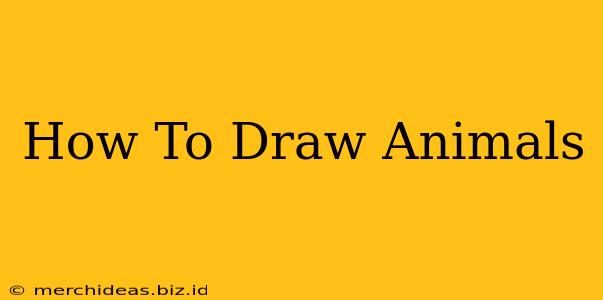Want to learn how to draw animals but don't know where to start? This comprehensive guide will take you from basic shapes to creating realistic and expressive animal portraits. Whether you're a complete beginner or looking to refine your skills, we've got tips and tricks to help you on your artistic journey.
Understanding Animal Anatomy: The Foundation of Realistic Drawings
Before you start sketching, it's crucial to understand the basic anatomy of the animal you're drawing. Don't worry, you don't need to be a veterinarian! Focusing on key features like the skeletal structure and muscle groups will greatly enhance your drawings.
Start with Simple Shapes:
Begin by breaking down the animal's form into simple geometric shapes like circles, squares, and triangles. This helps establish the overall proportions and posture before adding details. Think of a dog's body as a collection of cylinders and ovals, for instance. This simplifies the process, especially for beginners.
Observe and Study:
Real-life observation is invaluable. Spend time studying photographs or even better, observing live animals. Pay attention to their movements, postures, and the way light and shadow interact with their fur or feathers. The more you observe, the better you'll understand their unique characteristics.
Mastering Proportions:
Accurate proportions are key to believable animal drawings. Use references to help you understand the relative sizes of different body parts. For example, the length of a cat's head compared to its body, or the size of a bird's wings in relation to its overall size. Practice sketching these proportions repeatedly to develop your eye for accuracy.
Essential Drawing Techniques for Animating Your Sketches
Now that you've got a grasp of anatomy, let's dive into some essential drawing techniques to bring your animal sketches to life.
Light and Shadow: Creating Depth and Dimension
Mastering light and shadow is crucial for creating realistic animal drawings. Observe how light falls on the animal's fur or feathers, creating highlights and shadows that give it volume and depth. Practice using different shading techniques, such as hatching, cross-hatching, and blending, to create a sense of three-dimensionality.
Texture: Adding Realism Through Detail
Animals have diverse textures—smooth, rough, fluffy, etc. Use your drawing tools to replicate these textures. Experiment with different pencil pressures, line weights, and shading techniques to capture the unique feel of an animal's coat, feathers, or scales.
Adding Details: Eyes, Nose, and Other Features
The eyes, nose, and mouth are crucial features that give an animal its personality. Pay close attention to the shape, size, and placement of these features. Mastering these details adds character and realism to your drawings. Practice drawing these features separately before integrating them into your complete drawings.
Different Animal Drawing Styles: Experiment and Explore
Don't be afraid to experiment with different styles! From realistic portraits to cartoonish interpretations, the possibilities are endless. Explore different mediums like pencils, charcoal, pastels, or even digital art to find your preferred style.
Practice Makes Perfect: Your Journey to Animal Drawing Mastery
The key to becoming a proficient animal drawer is consistent practice. Set aside regular time for sketching, experiment with different techniques, and don't be discouraged by initial challenges. The more you draw, the better you'll become at capturing the beauty and unique characteristics of animals. Remember to celebrate your progress and have fun along the way!
Resources for Aspiring Animal Artists
Numerous online resources can help you on your animal drawing journey. Search for animal drawing tutorials, animal anatomy references, and drawing techniques on YouTube and various art websites. Consider following animal artists on social media for inspiration and guidance.
By following these tips and practicing regularly, you'll be well on your way to creating stunning animal drawings. Happy drawing!
